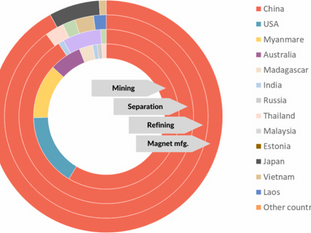top of page
In previous articles, we explained why recycling rare-earth permanent magnets (REPMs) is a strategic choice and yet, that it is limited due to technical, logistical and regulatory constraints. Therefore, REPMs recycling cannot be the only response to securing independent and sustainable supply and has to be part of a broader strategy. Several paths exist to achieve this objective: diversify primary supply, eco-design, and technological alternatives.
Diversifying primary supply remains the main strategy, and the most controversial. It entails opening new terrestrial mines across the globe, forming strategic alliances between politically aligned countries, and exploring deep-sea mining. These options might present additional and somewhat secure supply (that is debatable), but they come with a cost.
Creating supply chains between politically aligned countries risks creating a bridge between trusted and untrusted partners, raising costs, and excluding resource-rich countries. It is also based on partnerships which necessitate trust and are politically sensitive. The US was seen by the Western World as a trusted ally and partner, and is now becoming more and more unreliable and untrustworthy, which changes the geopolitical landscape.
Terrestrial and deep-sea mining both have heavy environmental and social consequences. In the case of deep-sea mining, the exact environmental consequences are yet unknown and could be so profound that it is arguably incompatible with current sustainable standards. Both these options also take time (years, sometimes decades) and investments before a permit can be granted, and before a mine can become fully operational. In the case of deep-sea mining, only small-scale projects have been launched, and an international regulation on shared standards is still being discussed.
Despite ongoing progress, recycling permanent magnets still faces major technical barriers, from coatings to complex disassembly. The second option to secure supply is to reduce demand. We can improve the way we use magnets and the devices in which they are embedded through eco-design and repair and reuse, thus reducing pressure on raw materials. Techniques exist to improve the lifespan of the magnet itself by improving its resistance to heat stress, mechanical fatigue, and oxidation, but the recurring trade-off is that it makes recycling more difficult (additional coatings for instance).


Eco-design at the product level entails improving the product’s lifespan, but also better design it so the REPMs inside can be easily dismantled without being destroyed. A project led by Terraquota® led to the successful recovery of several permanent magnets (not REPMs, but other types of permanent magnets. The design challenge remains the same) in heat pumps, because they were easily accessible and protected.
For instance, some magnets were not glued in one piece that would go all around the rotor, but rather into several pieces, which meant they were easier to detach in smaller pieces; the rotor had to be heated so the magnets would detach themselves easier, which was long and meticulous work, but it still allowed for the magnets to be recovered in separate pieces.
And finally, technological alternatives exist and are extensively researched so that we could simply not use REPMs. Two main avenues exist: rare-earth elements (REEs)-free magnets and magnets-free motors. Some REE-free magnets (ferrites for instance) and magnets-free motors are used, or have been (motors), but no alternatives provides a scalable solution to the problem and none of them can replace REPMs.
Their main issues are:
Lack of performance: they cannot compete with the power density, efficiency, and thermal stability of virgin NdFeB magnets.
High switching costs: using an alternative might reduce raw material costs, but transfer costs to other levels. Devices without magnets for instance are heavier and bulkier. Switching to alternatives requires changing the whole system, and it is a trade-off that is not economically neutral in high-end applications (mobility, defense, aerospace, energy…).
Supply concentration risk: REE-free magnets do not mean critical raw materials-free magnets. These alloys include nickel, cobalt, or manganese, all classified as critical raw materials by the EU.
Industrial maturity: Alternatives are still at the pilot or research stage. Their production processes are expensive, inconsistent, and not yet designed for high volumes of production.
So, where does this leave us?
Recycling rare-earth permanent magnets is essential, but not sufficient. In order to improve their recycling capacities, we need:
Technological innovations so that recycling technologies can be scalable.
Sobriety: reduce demand in order to reduce pressure on primary raw materials and allow recycling capacities to catch up. They will never fill 100% of demand, because no matter how slower it gets, it is still growing, and recycling does not create new magnets - only keeps them circulating. But reducing demand can help recycling capacities to satisfy more demand.
Industrial eco-design: making the REPMs traceable, easy to find and dismantle.
Build trust in the secondary REPMs market: establish labels and guarantees.
To fill the knowledge gap between China and the rest of the world regarding REPMs manufacturing, and REEs refining and processing, to gain industrial know-how and resilience.
Bottom line, and to finish this series of articles, the world is chasing a moving target. Demand for energy and digitalisation will keep growing, and with it, demand for REPMs. Recycling alone will never satisfy a growing demand because it does not create new magnets - only keeps them circulating.
Related Posts
bottom of page






